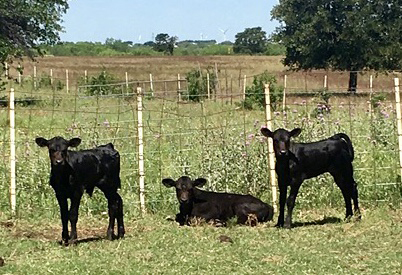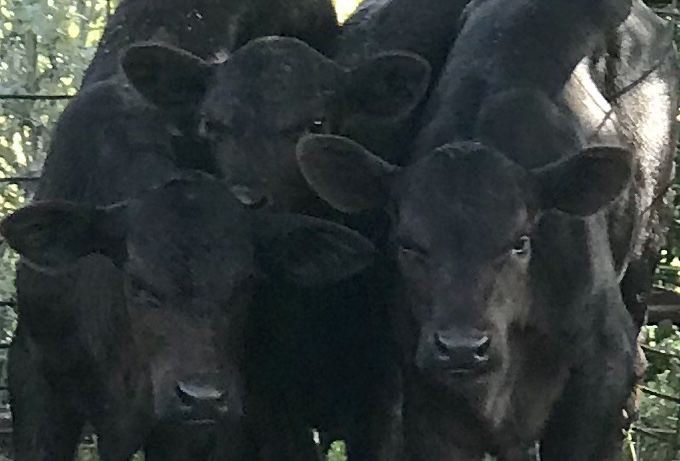Farm & Ranch
Heifer gives birth to triplets in Young County


A heifer from North Texas recently defied the odds when she delivered not one, not two, but three calves earlier this month, an occurrence that happens in only one out of every 100,000 births.
The first-time mom and her triplets, two bulls and one heifer, are reported to be thriving by their owners, Sam Gleaves and his wife, Linda. The pair, along with Christella Jones, run Jones Ranch, located in the small rural community of Farmer, Texas, just 10 miles from Loving in Young County. The ranch contains more than 1,000 acres with 130 cow-calf pairs.
The black Angus heifer is around the age of three and was bred with a half Corriente bull. When she went into labor, the timing just happened to be perfect as Gleaves was just stopping by to check on her and the other cattle.
“The delivery went really good. I just happened to be over there, I try to check them every day, and thought she had twins because there were no other heifers around. We had two sets of twins then already. I didn’t bother her, she was taking care of them,” recalled Gleaves.
The rancher left his new mom alone and returned around 30 minutes later and received the shock of his life when there was a third baby on the ground.
“I thought this can’t be right,” chuckled Gleaves. “But there were four other heifers left and they weren’t even showing they were going to have calves yet, probably only four or five months, no bags or anything. They had to be hers. My wife looked up how rare it is, and it’s unbelievable it happened.”
It would be understandable for a first-time mother of three to be overwhelmed, but so far the triplets are being well taken care of and seem to be flourishing.
“She is a great mother, she takes care of all three of them,” explained the rancher.
To Gleaves’ surprise, the mother had a bit of help from the other cattle shortly giving birth.
“What is funny is when she had that third one, the other four heifers came over and started helping her clean them up. It is like they are sisters or something, they knew she was busy and I’ll be darn if they didn’t come over there. I thought that was really something they helped her out,” said Gleaves.
It was one of the more surprising moments of his ranching career, which started around 18 years ago. The couple first trained horses in Colleyville, when Gleaves’ father-in-law, Bob Jones, offered him a job in the electrical business. Eventually, his in laws bought the Jones Ranch.
“Linda and I decided no one else in the family really wanted to take over the ranch, so when the electrical business sold we moved up here around 18 years ago. It was 500 acres, and no one wanted to mess with cows, so we did and since then the ranch has grown to 1,000 acres with 130 cow calf pairs,” said Gleaves.
His father-in-law has since passed, but Christella Jones, his 86-year-old mother-in-law, lives on the ranch. Born in Farmer with her five sisters, she returns to the roots where she was born.
It is around Jones’ house where the triplets now live, playing and growing under the direction of their mom and two older cows as the ranchers keep an eye on coyotes and any other dangers that might present themselves.
Farm & Ranch
Managing Show Cattle Through The Winter

By Heather Welper
Husband and wife duo, Heather and Calvin Welper, are the Co-Owners and Operators or Two C Livestock, located in Valley View, Texas.
The pair’s operation has a show cattle focus where they raise and sell purebred heifers of all breeds and club calf Hereford steers.
When it comes to show cattle, the Welpers know a thing or two including how to prepare for the cold winter months and the Texas major show season run.
To read more, pick up a copy of the November edition of North Texas Farm & Ranch magazine, available digitally and in print. To subscribe by mail, call 940-872-5922.

Farm & Ranch
Double M Ranch & Rescue

By Hannah Claxton, Editor
As the sun rises each day, so do the dozens of mouths that Meghan McGovern is responsible for getting fed. Rather than the sounds of a rooster crowing, McGovern hears the bellows and bleats of a variety of exotic deer, the chortle of kangaroos, the grunts of water buffaloes, and the chirps of a lemur.
Nestled against the banks of the Red River, the Double M Ranch and Rescue, with its high game fences and deer sprinkling the landscape,s its in stark contrast to the surrounding ranches.
“Having deer is kind of like eating potato chips- you can never actually have just one,” said McGovern with a laugh.
McGovern has several herds to take care of- fallow deer, axis deer, water buffalo, goats, and bison. In smaller numbers, there’s also a few kangaroos, a lemur, a potbelly pig, a pair of zebras, a watusi, and a few horses.
To read more, pick up a copy of the November edition of North Texas Farm & Ranch magazine, available digitally and in print. To subscribe by mail, call 940-872-5922.

Farm & Ranch
Acorn Toxicity

By Barry Whitworth, DVM, MPH
With the prolonged drought, most pastures in Oklahoma end up in poor condition. With the lack of available forage, animals may go in search of alternative foods.
If oak trees are in the pastures, acorns may be a favorite meal for some livestock in the fall. This may result in oak poisoning.
Oak leaves, twigs, buds, and acorns may be toxic to some animals when consumed.
To read more, pick up a copy of the November edition of North Texas Farm & Ranch magazine, available digitally and in print. To subscribe by mail, call 940-872-5922.

-

 Country Lifestyles2 years ago
Country Lifestyles2 years agoScott & Stacey Schumacher: A Growth Mindset
-

 Country Lifestyles8 years ago
Country Lifestyles8 years agoStyle Your Profile – What your style cowboy hat says about you and new trends in 2017
-

 HOME8 years ago
HOME8 years agoGrazing North Texas – Wilman Lovegrass
-

 Outdoor10 years ago
Outdoor10 years agoButtercup or Primrose?
-

 Country Lifestyles5 years ago
Country Lifestyles5 years agoAmber Crawford, Breakaway Roper
-

 Country Lifestyles9 years ago
Country Lifestyles9 years agoJune 2016 Profile – The man behind the mic: Bob Tallman
-

 Equine1 year ago
Equine1 year agoThe Will to Win
-

 Country Lifestyles8 years ago
Country Lifestyles8 years agoDecember 2016 Profile, Rusty Riddle – The Riddle Way




